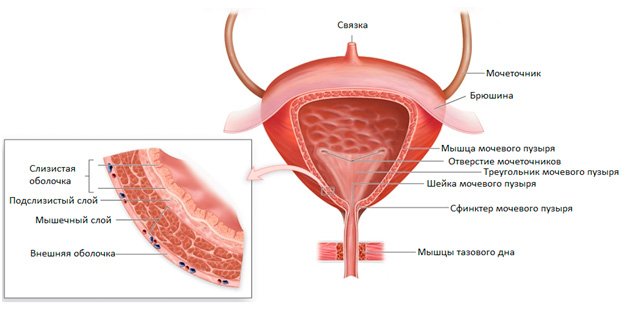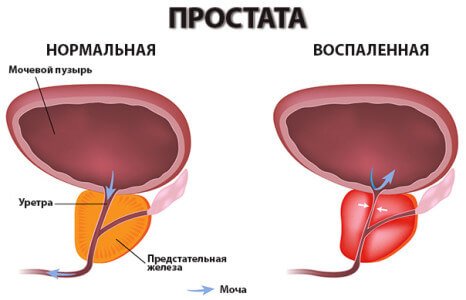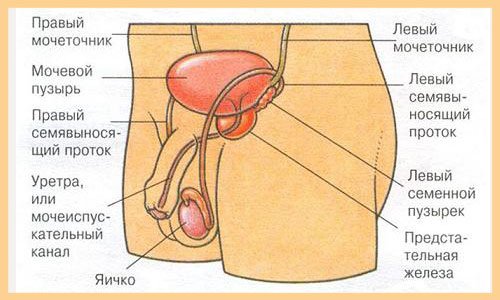Bladder: anatomy, normal volume in men, how to strengthen
575
Bladder: anatomy, normal volume in men, how to strengthen
Where is the bladder located in the representatives of the stronger sex, what is its structure and what pathologies can there be? The health of the genitourinary system for men is very important. Many men, feeling pain in the abdomen, do not even realize that this may be due to inflammation of the urea. To know what pathologies you may encounter, you need to have an idea about the structure of the bladder, and what this organ is for. Where is the bladder located, what are the volumes of this organ in men, and what diseases can cause a violation of the volume? All these questions will be answered in this article, as well as photos of the bladder.
Structure and location of the male bladder
The bladder is an organ that is hollow inside, looking like a reservoir in which urine accumulates for its further removal to the outside. The structure of the bladder in men is similar to the structure of this organ in the fairer sex. But in men, the prostate and seminal ducts are attached outside the urea.
Where is the bladder located in healthy men? It is located in the small pelvis. In front of the bladder is the pubic symphysis. These organs are limited from each other by a layer of fiber. The walls of the urea are covered with a mucous membrane, followed by a submucosa and a layer of muscles.
The inside of the bladder is lined with a mucous membrane. Above this membrane is the transitional epithelium of the bladder. This layer is extremely important because it does not allow pathogenic bacteria to penetrate inside. In some pathologies, the epithelium degenerates, and it becomes keratinized. When the transitional epithelium of the bladder is disturbed, this organ becomes defenseless, it constantly becomes inflamed, annoying with unpleasant pain symptoms. It is worth noting that this pathology manifests itself in almost the same way as cystitis, but therapy against cystitis in this case is ineffective, so accurate diagnosis is important.

When the transitional epithelium of the bladder becomes keratinized, this process is called leukoplakia. This is a serious disease, it is considered a precancerous condition, so it is unacceptable to leave it without therapy.
The submucosa of the urea allows it to fold. After the substitial base is the muscular layer. On the border between the urethra and the bladder itself, there is a sphincter, when it opens, urine comes out. Also, the bladder is supplied with nerves and blood vessels.
Normal urea volume in the stronger sex
The volume of the bladder in men on average is about 500 milliliters, plus or minus 100 milliliters. However, due to its elastic walls, it can be stretched to a large extent, so much more liquid can be placed in it. The normal capacity of the bladder in a healthy man reaches a liter.
The minimum size should not be lower than 350 milliliters, and the maximum - 650-700 milliliters. It is important to know that the need to empty the urea in a man should not exceed 8 times a day, when the urge is more frequent, you need to contact a urologist.
Pathologies affecting the change in the volume of the bladder
The volume of the bladder is affected by various diseases and disorders:
- Surgical operations;
- Age changes;
- Neurological problems and severe stress;
- Various pathologies of other organs.
A decrease in the volume of the urea occurs with the following diseases:

An increase in volume occurs with the following pathologies:
- Artificial diversion of urine;
- in the bladder;
- Multiple sclerosis;
- Swelling of the bladder due to medication.
Ways to restore normal bladder volume
To increase the volume of the bladder, the following methods are used:
- Conservative treatment involves stretching the bladder by filling it with fluids. Also, the patient can be prescribed special injections that enhance the cumulative capacity and restrain the urge to urinate;
- Surgical methods for stretching the bladder can be different: operating on the nerves of the walls, removing a section of the sacral muscle, replacing part of the bladder with a section of the stomach or intestines;
- Physiotherapy. There are certain techniques that allow you to train the bladder and increase its volume, for example, a man is prescribed the use of a large amount of fluid, while he should try to delay urination. In the process, he must stop, and then continue the outflow of urine.

To reduce the volume of this organ, the following methods are used:
- drug therapy;
- Insertion of a catheter to drain urine;
- Physiotherapy and exercise therapy.
Diseases of the male genitourinary system
The bladder in men can suffer from various kinds of diseases, among them the most common are:
- . With such a pathology, a man is not able to empty himself on his own. Basically, this problem occurs with adenoma or prostate cancer, but can also be observed with diseases of the nervous system, blockage of the urethra, injuries of the urethra. This condition requires immediate treatment and the use of a catheter;
- . This disease can be cured provided that it is detected at an early stage. Urinary cancer is more common in men than in women. It is mainly found in patients 40-60 years old. During the treatment, the tumor is removed, ureteroplasty is performed, radiation and chemotherapy are performed;
- . Basically, this pathology is inherent in older men. With this disease, the urge is sudden and frequent, and the process of urination is plentiful. The cause is infection of the organ, stroke or Parkinson's disease. In the course of treatment, drugs are prescribed, a urination schedule is established and special exercises are carried out;
- Cystitis. Such a pathology often develops against the background of the presence, penetration of infection, with injuries and urinary retention. With ineffective treatment of cystitis, it becomes chronic and in this case a complication may occur - kidney damage.
Bladder problems occur due to the following reasons:
- Failures in the exchange process;
- Getting into the organ of infection;
- spinal cord injury;
- Penetration into the bladder of foreign bodies;
- Leading an unhealthy lifestyle.
If the bladder becomes inflamed in men, the following symptoms occur:
- Frequent urination;
- The appearance of blood and various impurities in the urine;
- Incontinence or retention of urine;
- abnormal smell of urine;
- Pain in the lower abdomen, as well as in the genital area and rectum.
In the presence of pathologies of the bladder, the life of a man is greatly complicated. He is constantly in a stressful state, loses the opportunity to sleep well, his quality of life worsens. Men should understand that many problems of the genitourinary system are curable, you should not give them the opportunity to ruin your life, you should contact a urologist in time.




